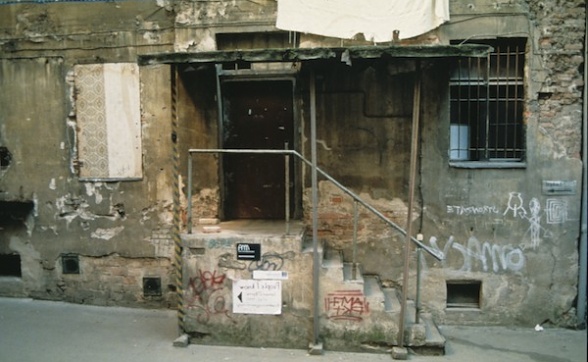| M | T | W | T | F | S | S |
|---|---|---|---|---|---|---|
| 1 | 2 | 3 | 4 | 5 | 6 | 7 |
| 8 | 9 | 10 | 11 | 12 | 13 | 14 |
| 15 | 16 | 17 | 18 | 19 | 20 | 21 |
| 22 | 23 | 24 | 25 | 26 | 27 | 28 |
| 29 | 30 | 31 | ||||
Nina Fischer and Maroan el Sani have been photographing the entrances to temporary nightclubs in Berlin. Because they are illegal, these venues are often only occupied for one night, and the signs of the event are ephemeral graffiti and posters. The artists were invited to seek out and document similar events in Liverpool, a city famous for its club life. As it turned out, Liverpool did have such clubs 10 or 15 years ago, but these have now become established venues. The artists decided not to show the entrances of these more established spaces, but instead to find obscure sites where a club could have been (or might one day be held). They brought with them posters made from their Berlin photographs, which they put up near the entrances of these phantom sites. They then re–photographed the posters in situ. The resulting photographs will be run off as a poster series and pasted around Liverpool, suggesting potential or fictitious club sites. Back in the gallery space the Berlin club photographs and the phantom images will be hung together. Fischer and El Sani have made interesting comparisons between Berlin and Liverpool. Whereas Berlin has been attracting thousands of young people since the ’90s, Liverpool has been partially emptied since the decline of its shipping industry. Like the Mitte of Berlin when the wall first came down, there are whole areas of empty buildings that lend themselves to informal occupation. In Berlin this happened spontaneously. First came the squatters, many of whom were artists. The authorities accepted and even encouraged their activities just to get life back into the streets. It was in this climate that the clubs and bars flourished. Bit by bit this impromptu occupation has given way to planned urban development. ‘Liverpool is hoping for new inhabitants,’ they point out. ‘There are already a lot of young people, students for example, coming into town. Maybe the time will come soon when they need the space. Then the houses in the abandoned streets can be used again. We have already had a look around the streets, and there are places we would like to turn into bars or clubs.’
Liverpool Biennial
55 New Bird Street
Liverpool L1 0BW
- T +44 (0)151 709 7444
- info@biennial.com
Liverpool Biennial is funded by
Founding Supporter
James Moores
